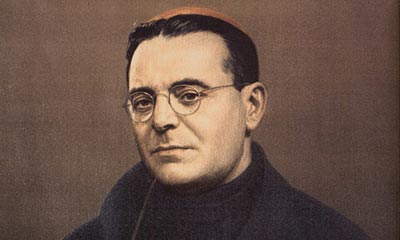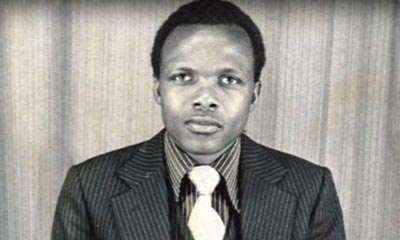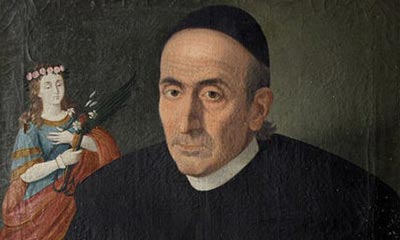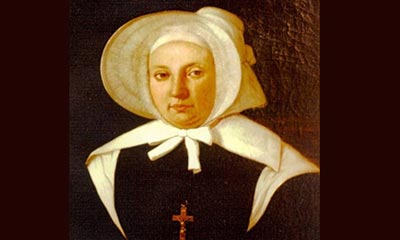May 10, 2022
Venerable Marie Magdeleine de la Croix
Dear Friends,
From the time she was a child, Mother Marie-Magdeleine of the Cross (1810-1889), founder of the Daughters of Mary, was deeply moved by the plight of those in slavery. She was convinced that former slaves should be welcomed into one and the same religious congregation with the daughters who came from the society of the free. In this way they would all be free, with the freedom of children of God. “This work, which I have been called to establish is abhorrent to the people of the world, even those who are consecrated to God”, she wrote, “for in order to crush the pride of the great and to reveal the excessive charity of Christ, this is about no less than a communion between the white women and the black women who will be forming this community.”
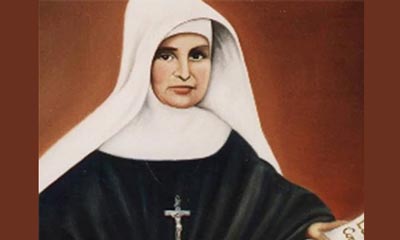 Marie-Françoise-Aimée was born on June 2, 1810 in Saint-André, on Bourbon Island. It is located east of Madagascar, in the Indian Ocean. It became a colony in its own right around 1710, after having served as a stopover for the French East India Trading Company. Subsequently, in the 1760s, it came under the direct control of the King of France, before being reallocated to the sugar cane industry under Napoleon. In 1848, the island received the name by which it is still known today, Reunion Island.
Marie-Françoise-Aimée was born on June 2, 1810 in Saint-André, on Bourbon Island. It is located east of Madagascar, in the Indian Ocean. It became a colony in its own right around 1710, after having served as a stopover for the French East India Trading Company. Subsequently, in the 1760s, it came under the direct control of the King of France, before being reallocated to the sugar cane industry under Napoleon. In 1848, the island received the name by which it is still known today, Reunion Island.
The youngest of four, Aimée was the daughter of Gaëtan Pignolet de Fresnes and Marianne Notaise, a widow who had three children by a former marriage. Monsieur Pignolet de Fresnes ran an agricultural and industrial estate named “Le Désert”. When she was two years old, following a custom of the time, Aimée was entrusted to a relative who had no children: her godmother, Madame Mézières de Lépervanche, who welcomed her to her estate in Sainte-Suzanne. Aimée suffered deeply from being separated from her parents. Her adoptive mother avoided upsetting her, being of poor health, and the little girl behaved like a spoiled child: lively and sensitive by nature, she would not accept even the slightest rebuke; she was capricious and every day picked the clothes she wanted to wear. Yet she also showed herself to be generous: she used her small savings to buy handkerchiefs which she discreetly slipped into the trunk of an elderly, blind slave from Madagascar, who had none. When she was eight years old, she showed an extraordinary love for the crucified Jesus: her gaze was drawn to Him like a magnet, and it focused on He who “suffered so much to forgive us”, as she herself wrote. One day, she witnessed a master savagely beating a slave: she stopped him. “I could not stand to see an unhappy person suffer”, she wrote in her intimate recollections, “the poor slaves had all my compassion. I abhorred masters who were harsh and even barbaric towards them; I suffered horribly whenever I knew that they were being chastised beyond the requirements of justice.”
Other forms of slavery
In our time, slavery still exists in other forms. In his message for the celebration of the 48th World Day of Peace on January 1, 2015, Pope Francis called attention to the victims of contemporary slavery: “All those persons, minors and adults alike, who are made objects of trafficking for the sale of organs, for recruitment as soldiers, for begging… Finally, I think of all those kidnapped and held captive by terrorist groups, subjected to their purposes as combatants, or, above all in the case of young girls and women, to be used as sex slaves. Many of these disappear, while others are sold several times over, tortured, mutilated or killed.” The Pope recalled the root cause of slavery: “Today, as in the past, slavery is rooted in a notion of the human person which allows him or her to be treated as an object. Whenever sin corrupts the human heart and distances us from our Creator and our neighbors, the latter are no longer regarded as beings of equal dignity, as brothers or sisters sharing a common humanity, but rather as objects. Whether by coercion or deception, or by physical or psychological duress, human persons created in the image and likeness of God are deprived of their freedom, sold and reduced to being the property of others. They are treated as means to an end.”
Aimée received the sacrament of Confirmation in 1817. At the time, she was attending catechism classes at Saint-André, and was able to pay visits to her family. Speaking of her First Communion, on May 18, 1823, she would later confess: “How happy I was! Naively, I believed that this joy would last forever!” When she was twenty years old, a bizarre illness struck: she experienced horrible migraines and unbearable itching all over her body. No remedy could relieve her, but she was almost happy in being able to suffer in that way for God’s sake; she noticed that the suffering was drawing her to Him. After this painful ordeal, she was more inclined to piety.
A nurse and a catechist
When the sugar crisis of 1828-1829 left her uncle ruined, he moved to Saint-André. Aimée, who still lived in his house, then made the church her second home. When her adoptive mother died in 1837, she returned to her parents, but once again her physical condition deteriorated. She resolved to accept her state of health as a penance, joined the Confraternity of the Sacred Heart of Jesus and started an apostolate among the slaves, tending to their bodily needs by becoming a nurse, and to their souls by teaching them the catechism. Word of her kindness soon spread; following the example of the slaves of the “Désert”, those from neighboring estates also came in the evenings to benefit from her teaching. Better to devote herself to the service of God, she transformed her own room into an oratory, and shared another with her sister. But their father, whose religious practice went no further than a limited degree of devotion to the Blessed Virgin, was afraid to see the house turned into a convent. He also had gone bankrupt, and was weakened psychologically; furthermore, he fell ill with a lung disease. Aimée worried about his eternal salvation and prayed for him to be granted a Christian death. When at last he consented to ask God’s forgiveness for his sins, to take Holy Communion and to receive the scapular of Our Lady of Mount Carmel, Aimée understood that her prayers had been heard. After her father’s death, she continued to wear mourning, as a sign of having cut herself off from the world.
It became clearer to Aimée that her vocation was to serve God through those who were most abandoned, especially the infirm, the elderly and lepers; she regarded this portion which the world rejects as her own. She confided her plan to Father Frédéric Levavasseur, of the Society of the Holy Heart of Mary. Himself a member of a religious order, he suggested that she adopt a strict rule of life, and encouraged her to continue her apostolate in the world in order to allow her plan to mature. Her desire was to found a new congregation, open to all girls regardless of their social status, “because”, she wrote, “before God, all men are equal; after death, we all become dust again, and at the hour of the last judgement, we shall all be measured in the same way.” She shared her idea with her sister Marie-Anne, who admitted to having the same desire. The idea of founding a congregation dedicated to Mary quickly emerged from their discussions. However, nothing could be accomplished before the abolition of slavery in the French colonies. A decree to that effect was published on December 20, 1848.
Flying in the face of prejudice
By taking in black girls—who only yesterday were slaves—together with white girls, Aimée was flying in the face of colour prejudice that plagued society in Reunion Island. Most did not believe that she would succeed, because she started out penniless. And while people avoided contradicting her to her face, she was generally dismissed as an exalted madwoman, and everyone predicted that she would fail. The first years of the congregation were marked by this climate of hostility. “Our work being the work of God”, she wrote, “it will succeed against all odds; no matter how much it will be opposed, it is Jesus who will show Himself in all that will be done, putting everyone in their proper place.” She insisted on the importance of trust in God: “Without trust in God, many a one would give in to discouragement. I tell you this to my shame, I feel that more than once I myself would have fallen into deep discouragement… It is Jesus, Mary, Joseph who support me. I look at the cross and beseech it to help me through this so hard and painful life.” Without any further ado, Father Levavasseur bestowed upon her the religious habit. On May 19, 1849, she took her vows and received the name of Mother Marie-Magdeleine of the Cross. It was not without reluctance and fear that she accepted the responsibility of becoming the superior of the first twelve postulants, including eight former slaves. In 1852, Marie-Anne, her biological sister, who until then had been obliged to remain by their mother’s side, joined the community where she took the name of Mother Marie-Thérèse of Jesus.
Years later, in 1858, Mother Marie-Magdeleine would write: “My God, how admirable are you in all that you do; you call to yourself, to establish a new foundation, the weakest, the most miserable, the least capable creature, she who has offended you more than the others… In short, you take for yourself everything that the world would have rejected a hundred times over.” She experienced the extreme desire to do the sole will of her divine Master and to seek Him alone. “It seems to me that the love I have for Him is as great and strong as Jesus himself, that it is neither the fear of hell nor the desire for Heaven that makes me love Jesus; I love Him out of pure love.” She regarded suffering as the cement of her attachment to Jesus, as the surest road to Heaven. She found comfort and strength at the foot of Calvary and of the tabernacle.
Placed between sinners and hell
The Daughters of Mary’s desire was to win a great number of souls to God by their prayers and their life of poverty, penance and toil. “How I suffer”, the foundress wrote, “when I think of the poor sinners! What would I not give to save their souls! When I think of all those whom I have left in the world, and who live as if they were going to spend eternity on earth! Spending their whole life in sin, not wanting to submit to the divine will, avoiding the thought of death, which will come knocking at their door at the moment when they least expect it… Lord, grant these poor souls your pardon! Oh, I would gladly give my life to snatch them from hell! Mercy, Lord! Place the poor Daughters of Mary between them and hell, so that through our intercession, our beloved Mother may save these souls who have cost you so dear!”
The Catechism of the Catholic Church recalls: “Death puts an end to human life as the time open to either accepting or rejecting the divine grace manifested in Christ (cf. 2 Tim 1:9-10). The parable of poor Lazarus (cf. Lk 16:22) and the words of Christ on the Cross to the good thief (cf. Lk 23:43), as well as other New Testament texts, speak of a final destiny for the soul—a destiny which can be different for some and for others. Each man receives his eternal retribution in his immortal soul at the very moment of his death, in a particular judgment that refers his life to Christ: either entrance into the blessedness of heaven—through a purification or immediately,—or immediate and everlasting damnation” (CCC, nos. 1021-1022). For he that will save his life, shall lose it: and he that shall lose his life for my sake, shall find it, says Jesus. For what doth it profit a man, if he gain the whole world, and suffer the loss of his own soul? (Mt 16:25-26).
In the years that followed the abolition of slavery, many former slaves were struggling: the elderly and the sick were deprived of care, children went without schooling, and young handicapped people were confined to their homes. Mother Marie-Magdeleine’s first action was to take a disabled little girl into the convent for her to be taken care of there. With her Daughters, she also worked in the private hospitals of Sainte-Suzanne and Saint-Gilles-les-Hauts. But her compassion and solicitude were especially centered on lepers: “The leper is the most unfortunate person in existence”, she wrote. “As soon as he is recognized as having this disease, his family rejects him. He must be confined, he must flee far from the world, for he inspires nothing but horror in all who see him… Lepers must be the Daughters of Mary’s very bread.” In 1856, she settled some of her Daughters in the leprosarium of Saint-Bernard. From there, she wrote to those living at Rivière-des-Pluies: “I went through this long room where fifty lepers greeted us with an expression of contentment, and I felt nothing but joy and happiness… What can I tell you about these poor creatures, except that one can draw many subjects of profound meditation from considering them.”
Making people love Saint Joseph
In 1859, the community left its original cob convent-house for Saint-Denis, the capital, moving into a stone building called “La Providence”. Mother Marie-Magdeleine had a boundless confidence in Divine Providence: “I never worry about tomorrow”, she said, “I know that God will give me what I need, and we need no more… Knowing that whenever I had recourse to Jesus and Mary for even the slightest need, I saw that my request was granted, I would have to be a fool to do anything else but knock on the door of their divine Hearts. A piece of bread given to me by Providence is to me a thousand times better than the most exquisite dishes that I would owe to the whims of men. One day you are in their good graces, and they will raise you to the skies, but the next, if they are feeling contrary, they will no longer think of you.” She was also pleased to have chosen Saint Joseph as her bursar: “It seems to me that the tenderness I have for this great saint is a gift given to me by Jesus; it seems to me that Saint Joseph is mine, that there is something that unites me to this good Father that I could not produce of myself, but that makes it impossible for me to do without him, because that is what Jesus wants. I would like to make everyone love him… When I need something for the community, I write him a little note, or, kneeling at his feet, I tell him about my needs, I tell him what I want, and then I go away, quite sure that I will be heard.”
On the occasion of the 150th anniversary of the declaration of Saint Joseph as Patron of the Universal Church by Blessed Pope Pius IX, Pope Francis shared some reflections on this exceptional figure: “Each of us can discover in Joseph—the man who goes unnoticed, a daily, discreet and hidden presence—an intercessor, a support and a guide in times of trouble. Saint Joseph reminds us that those who appear hidden or in the shadows can play an incomparable role in the history of salvation… The greatness of Saint Joseph is that he was the spouse of Mary and the father of Jesus. In this way, he placed himself “at the service of the entire plan of salvation”. Thanks to his role in salvation history, Saint Joseph has always been venerated as a father by the Christian people… Innumerable holy men and women were passionately devoted to him. Among them was Teresa of Ávila, who chose him as her advocate and intercessor, had frequent recourse to him and received whatever graces she asked of him. Encouraged by her own experience, Teresa persuaded others to cultivate devotion to Joseph… Popular trust in Saint Joseph is seen in the expression ‘Go to Joseph’, which evokes the famine in Egypt, when the Egyptians begged Pharaoh for bread. He in turn replied: ‘Go to Joseph; what he says to you, do so’ (Gen 41:55). Pharaoh was referring to Joseph the son of Jacob, who was sold into slavery because of the jealousy of his brothers (cf. Gen 37:11-28) and who subsequently became viceroy of Egypt (cf. Gen 41:41-44)” (Apostolic Letter Patris corde, no. 1).
Mother Marie-Magdeleine sent sisters to those places where poverty was greatest. Before long, she had founded seventeen communities in Reunion Island. She also helped the poor in neighboring countries: Mauritius, Madagascar, the Seychelles, but also in Africa. The project in the Seychelles could not be completed during her lifetime; on the other hand, as early as 1860, the Daughters of Mary were present in Africa. Mother Marie-Magdeleine experienced the sending of young sisters to countries where Muslims were in the majority as a heavy responsibility: “I suffered more on seeing my sisters leave for Africa than when I closed the eyes of those who died”, she confessed… But on the other hand, she added: “Let us not forget that only yesterday, Bourbon was bringing in slaves from Africa. It was in some ways quite satisfying to see the girls whose parents had come to Bourbon as slaves leave to educate and care for their brothers. They were returning to their roots in a way that was not commonplace. God wanted it that way, may He be praised for it!” Her own sister, Mother Marie-Thérèse of Jesus, contracted fever while visiting the communities in Africa. Her death, on the first Friday of April, 1868, was “the most terrible and complete sacrifice that God could have imposed on me,” said Mother Marie-Magdeleine… From then on, I was to lean only on my cross, and it was at its foot that I was to pour out all the bitterness of my heart… God wanted me to be alone in the midst of my sufferings, so that I might learn that I must cling to Him alone.”
The founding Mother recommended to her Daughters the assiduous practice of the virtues of poverty, obedience, humility and charity. “I believe that God will richly reward those who do everything to maintain peace in the congregation. It will only be at the cost of many a sacrifice, but what does it matter, if we can spread the glory of God and help our sisters to sanctify themselves! We must do God’s will where He wills and as He wills.
We must know what God wills, for everything lies therein; each day teaches us that life is a succession of sufferings which we must be able to bear in calmness and peace, in order to try to deserve Heaven, whatever the cost. Heavenly repose will be so sweet after the terrible struggle on earth!”
Give, and I will give back to you!
From 1873 onwards, Mother Marie-Magdeleine’s health was badly weakened by malaria. On 16 January 1882, Father Levavasseur, her spiritual father and the co-founder of her work, was summoned into eternity. In 1887, another trial awaited her: the communities in Mauritius separated from the congregation.
In January 1889, on her deathbed, Mother repeated tirelessly to her Daughters: “Charity for the poor, for the children, for the orphans, for the elderly… Give, give, my Daughters, I promise to have all you give, given back to you a hundredfold when I am in heaven.” She died peacefully on January 27. In 2007, Pope Benedict XVI recognized the heroic virtues of Mother Marie-Magdeleine of the Cross. Today, the congregation of the Daughters of Mary has more than 300 nuns in about 50 communities. They exercise their apostolate in Reunion, Mauritius, Rodrigues, Madagascar, the Seychelles and Africa.
May the venerable Mother Marie-Magdeleine of the Cross help us to put into practice the new commandment that Jesus left us: Love one another as I have loved you! (Jn 13:34).






